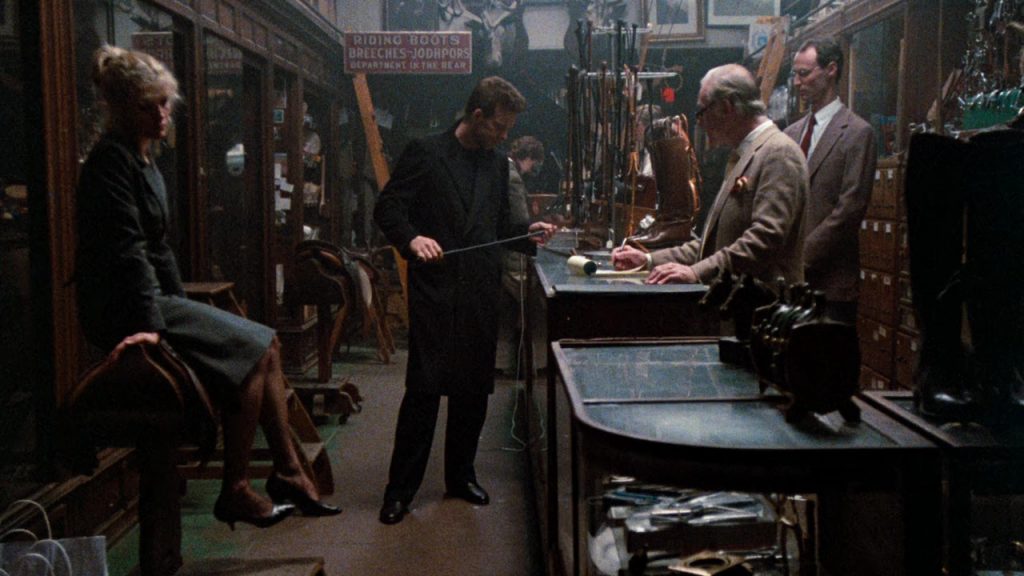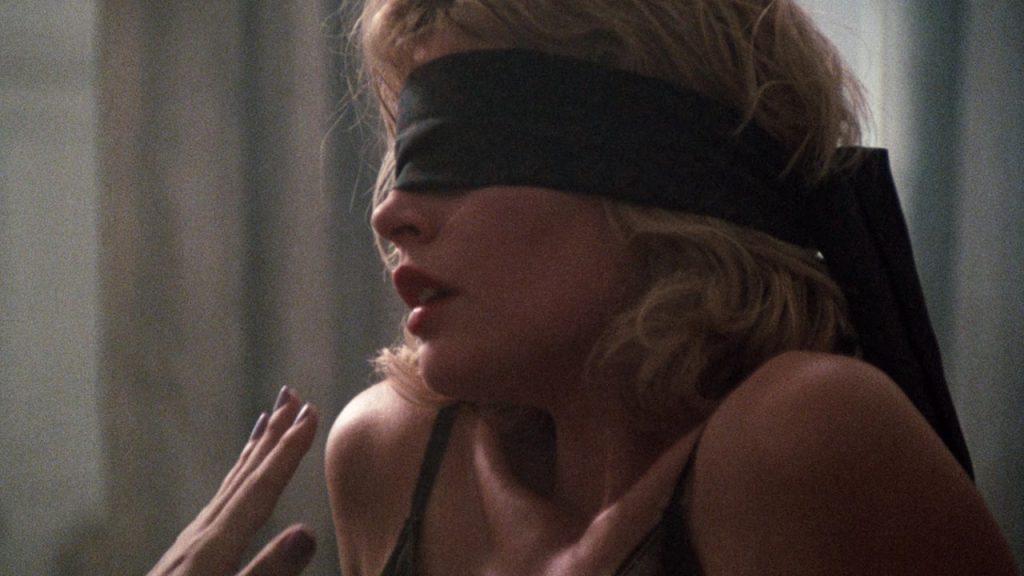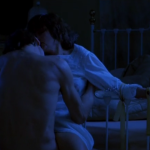John: “Elizabeth, I don’t want to negotiate with you. Now crawl.”
Nine and a Half Weeks (IMDB) is a 1986 erotic drama/romance film, directed by Adrian Lyne, starring Mickey Rourke and Kim Basinger. Written by Patricia Knop & Zalman King and Sarah Kernochan.
Adrian Lyne previously directed Flashdance (1983) and later directed controversial, sexually-charged films like Fatal Attraction (1987) and the remake of Lolita (1997). He learned filmmaking as a commercial director in London.
Zalman King, the driving force of the film as one of the writers and producers, is an interesting figure in the history of visual erotica. He had a middling career as an actor, going back to the 60s. After Weeks, King started directing softcore erotica features, borrowing a lot of Adrian Lyne’s style. In the 1990s, he created the adult anthology series Red Shoe Diaries, which pioneered a particular style of high-gloss softcore erotica suitable for the mixed gender, home-viewing audience, and the later Chromium Blue series. For better or worse, Lyne and King defined what some people thought “visual erotica” should be.
Hallmarks of the Lyne-King style: Heterosexual, with occasional girl-girl scenes. No frontal male nudity, and definitely no erect penises. Definitely going further than network TV, but stopping before hardcore porn. Loving high-contrast closeups on consumer goods like CD players and food. A middle-class aspirational aesthetic.

According to Job Bob Briggs’ Profoundly Erotic: Sexy Movies That Changed History (Universe, 2005),
“9 ½ Weeks was based on a 1978 novella written under the pseudonym Elizabeth McNeill, that […] amounts to a woman’s descent into madness as she becomes addicted to a sadistic lover. […] She knows that she’ll have to tear herself away or go crazy. In fact, she does tear herself away, but she suffers a breakdown as a result.” [Pg.275]
“When the book fell into the hands of novice filmmaker Zalman King, he was fascinated. He showed it to his wife, artist-sculptor Patricia Louisiana Knop, and the two of them started arguing at once: He loved it; she hated it. And yet the more they talked about it, the more they both loved it and wanted to see it made into a movie. “It’s such a romantic concept,” Knop would finally admit — the idea of simply dropping out of your normal everyday life for a while and giving yourself to a man to do with as he pleased. That man, she finally decided, really did love the object of his obsession. He was testing her because he wanted an equal in every way. The story, King and Knop agreed, was feminist at its heart.” [Pg.275]
If the original novella was “not a love story”, King and Knop were determined to make it one. Their first-draft screenplay was reportedly as dark as the source material, and an early cut of the film screened for a test audience in early 1985, where out of a test audience of 1000 people, 960 left in the middle. [Briggs 2005 Pg. 274] There’s a complex push-and-pull between the dark psychodrama of the original novella and the frothy romance it almost ended up being.
We’re introduced to Elizabeth (Kim Basinger), a divorced art gallery manager in 1980s Manhattan. She meets John (Mickey Rourke) while out in the city. From their first meeting, John is constantly testing and controlling Elizabeth.
He is what people now would call an edgelord. When they eat Italian together, he tells her about the mobsters who were supposedly killed in the restaurant. He leads her to a houseboat where he puts on music, specifically Billie Holiday singing, “Strange Fruit”, which is about lynching. He brings up the fact that they’re strangers and a long way from anybody else on the houseboat.
Elizabeth: “I don’t like this. I want to go home.”
John: “I was just kidding.”
By modern standards, John is giving all the signs of an abusive partner. Regardless, she keeps seeing him, and he keeps escalating. On their second date, he puts her in a Ferris wheel by herself and gets the operator to leave her at the top. At her place, he blindfolds her with a white silk scarf and teases her with ice.
John is an enigma, without even a surname. (The indirect sequel, Love in Paris (1997), lists the character’s name as “John Gray”, which suggests a link to the male leads of both Secretary and Fifty Shades of Grey.) At the end, he starts to tell Elizabeth about his past, mentioning he had a working class background, and was the youngest of six brothers. It suggests that the only way he knows how to be intimate with someone is through never ending testing and teasing.
From a BDSM perspective, what John does with Elizabeth isn’t a problem. The context of their relationship is: There’s no trust, no negotiation, no agency for Elizabeth. She has no idea if he’s going to be Jekyll or Hyde when she sees him. His game might be sweet and playful, like when he teases her with different foods, from honey to jalapeno peppers; or it might be harsh and humiliating, like when he throws money on the floor and demands she crawl around and pick it up, even pulling off his belt and hitting things (not her, at least).
It’s particularly disturbing in light of the manipulation the filmmakers put King Basinger through. The crawling-for-money scene was a screen test she did with Rourke for Lyne. Basinger said, “I’d heard many girls had come in to test and were quite sexually open to doing anything to get the movie. Well, I was just 100 percent defiant. I was just out of my mind, and as we went through the scene I just came completely apart, emotionally. I couldn’t deal with it. I cried and cried, out-of-my-mind wrecked. But again, that was also what Elizabeth would do.” [Briggs 2005, Pg.278]

They didn’t want somebody who was willing to play submission and humiliation. They wanted somebody on that edge between outright refusal and playing along, who was willing to be strained by the experience. That was Kim Basinger and they kept her on that edge throughout the shooting of the film. Scenes were actually shot in the story order, a rarity, and she was isolated from the rest of the cast and crew, in order to get an authentic performance out of her.

In a scene at a riding goods store, John makes a big production out of testing a riding crop, whipping it through the air and annoying the sales clerks. Elizabeth looks bored, and barely reacts when he lightly taps her on the thigh, over her skirt.
The crop appears once later, along with a pair of handcuffs, as props in Elizabeth’s iconic “You can leave your hat on” dance. However, they only appear briefly at the beginning of the dance. It’s strange that the film includes the scene of John selecting the crop, but he never uses it, and it only appears in Elizabeth’s hands. John got his exhibitionist thrill out of being seen buying it, rather than using it. Roger Ebert wrote, “In a movie like this, to buy a whip and not use it is like Camille coughing in the first reel and not dying in the last.” [Briggs 2005, Pg.281]
This fits into the consumerist ethos of John and the film as a whole. He’s a banker, and he is surrounded by the trappings of money and wealth. Much of his interactions with Elizabeth involve him buying things and putting them on her: an expensive scarf; a gold watch with the command to look at it and think of him every day; a pinstripe suit to rhyme with his; a man’s suit and fake mustache so she can do male-drag; etc. The crawling-for-money scene is just the logical extension.
This isn’t Elizabeth’s breaking point. That comes later.
On the evening of a big gallery show, Elizabeth checks out of her responsibilities to go on one of John’s mysterious assignments. She goes to a grungy hotel, blindfolds herself (black silk, this time) and waits. John brings in a Spanish-speaking woman to fondle her while making cat purr noises. This character, played by Cintia Cruz, is only credited as “Whore”. She’s also the most prominent person of color in the whole film.

When John ignores Elizabeth in favor of the other woman, she runs out, into the excesses of pre-Giuliani Times Square. John gives chase, saying, “How does it feel to be out of control, Elizabeth?”
In a live sex show, they observe the performers. Elizabeth kisses one of the men in the audience, then goes back to the gallery, where she has some kind of panic attack.
The next morning, Elizabeth leaves him, though John tries in vain to explain himself. No indication of what comes next for either of them.
Briggs’s criticism is that Weeks goes too far to the light romance side of the dialectic. “… we don’t believe that the rug has been pulled out from under her so much as that she’s having a good time in a fresh and novel way — and perhaps that’s why the film found its audience not among the true devotees of S&M but Bondage Lite girls who like to wear the clothes and assume the postures.” [Pg. 281] Obviously, some people would consider the film plenty dark enough.
9 ½ Weeks is the forerunner of the female-friendly, slightly-kinky, slightly-edgy erotica genre. Fifty Shades of Grey continues it, including an ending in which the woman decides to leave the man. However, the two sequels of Fifty Shades recuperate it into the ideology of romance by engineering a happily-ever-after ending. Shades says the volatile, controlling and edgy bad guy can be redeemed into a husband and father.
[Note that in the Fifty Shades movies, Kim Basinger played Elena Lincoln, the former lover and dominatrix of Christian Grey, and another target of Ana’s paranoid jealousy. I’d call this a meta-commentary if that wasn’t giving the filmmakers too much credit.]
If Weeks is the prototype of kind of narrative represented by Secretary and Fifty Shades, in which the sadomasochistic man is recuperated into normative marriage and family, then Bound is a return to the roots, acknowledging that the sadomasochistic man can bring about a woman’s transformation, without trying to squeeze him into the standard marriage plot. Bound is the original Nine and a Half Weeks, but with a happy ending.



